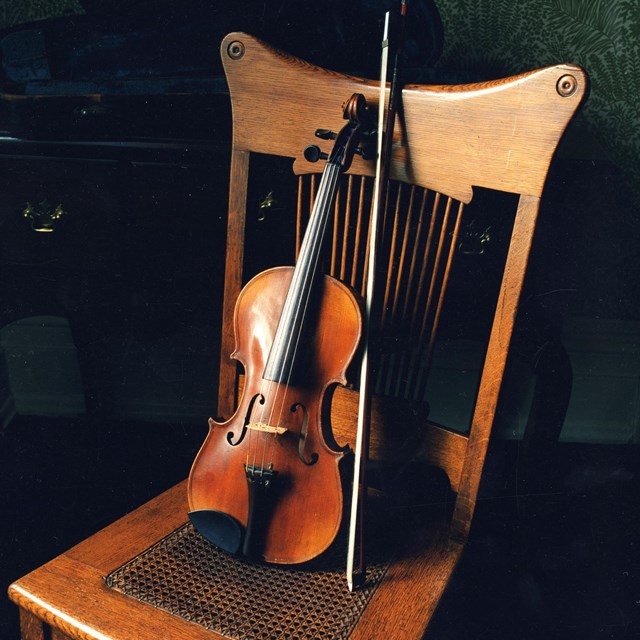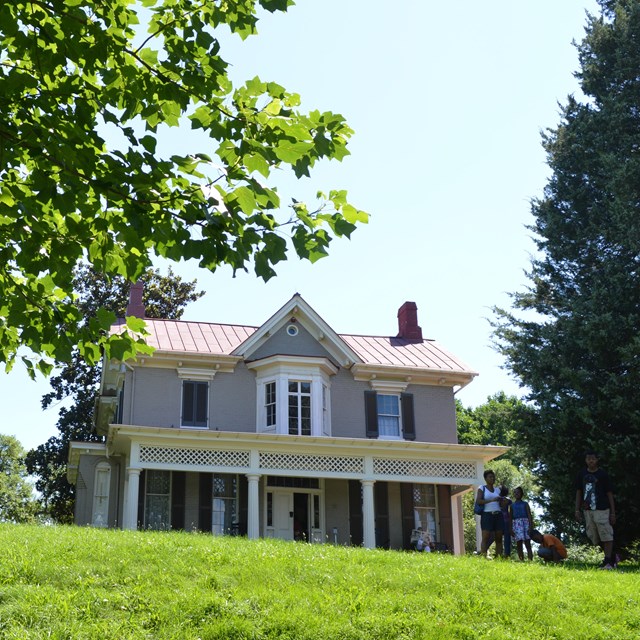|
Cedar Hill has been saved through the foresight and dedication of various groups and individuals over many years. The historic house has operated as a museum for more than a century. It is through the determination of so many people that Cedar Hill is now a national historic site, where everybody can visit and be inspired by the legacy of Frederick Douglass. For a complete history of the preservation of Cedar Hill, click here. For a timeline, view below. 
Library of Congress Turning Cedar Hill into a Historic SiteAugust 31, 1886 - Frederick Douglass devises his will, leaving most of his real estate and investments to his four adult children. He leaves Cedar Hill and most of his personal property to his wife Helen. February 20, 1895 - Frederick Douglass passes away. His will is later executed, and his widow Helen receives Cedar Hill. July 18, 1896 - Helen Douglass invites members of the National League of Colored Women to Cedar Hill to raise support for establishing it as a historic site. Soon after, she announces through the Evening Star that she plans to create an association "to encourage the people throughout the various states to make pilgrimages to the Douglass estate." June 6, 1900 - Congress charters the Frederick Douglass Memorial and Historical Association (FDMHA), a non-profit group formed by Helen Douglass with the mission "to preserve to posterity the memory of the life and character of the late Frederick Douglass" and "to collect, collate, and preserve an historical record...of the anti-slavery movement" at Cedar Hill. December 1, 1903 - Helen Douglass passes away, leaving Cedar Hill to the FDMHA in her will. There is a $5,500 mortgage on the property. 
Library of Congress Ensuring Cedar Hill's SurvivalMay 3, 1904 - Archibald Grimke, president of the FDMHA, reports to district commissioners that the FDMHA has stationed staff at Cedar Hill "to show visitors the effects of the late Frederick Douglass and also to show them over the estate." It is later announced that the FDMHA has received a tax exemption to carry out its mission. March 20, 1908 - Booker T. Washington initiates a national fundraising campaign for the FDMHA, soliciting donations to turn Cedar Hill into a "Mecca." Washington's efforts, along with those of the FDMHA trustees, help reduce the mortgage to $4,000 by 1916. July 1916 - At the urging of the FDMHA, the National Association of Colored Women (NACW) agrees during its biennial meeting to help pay off the remaining mortgage on Cedar Hill in time for the centennial of Frederick Douglass's birth. The effort is spearheaded by NACW President Mary B. Talbert. July 1918 - The NACW is successful in paying off the entire mortgage on Cedar Hill. They celebrate at their biennial meeting in Denver, Colorado, by having donor Madam C.J. Walker burn the paperwork in front of a large audience. Over the next four years, the NACW raises and spends an estimated $11,000 "to restore, rehabilitate and beautify the Home," in the words of Hallie Q. Brown. August 12, 1922 - The FDMHA and the NACW celebrate the first restoration of Cedar Hill by hosting a large ceremony at Cedar Hill. Robert R. Moton, president of Tuskegee Institute, is the keynote speaker and Joseph Douglass, grandson of Frederick and Anna Douglass, plays his violin for the audience. 1928 - The NACW pays for the construction of a caretaker's cottage behind the historic house for employees of the FDMHA to occupy. July 1938 - Under the leadership of Mary McLeod Bethune, the National Youth Administration restores the grounds, pathways, and historic structures at Cedar Hill. The Works Progress Administration catalogs objects in the collection. 1950s - The FDMHA organizes boy scout groups and community members to perform maintenance work at Cedar Hill. Members of the FDMHA report difficulty in maintaining the property and are considering giving it to the federal government. Elevating Cedar Hill to National StatusSeptember 5, 1962 - President John F. Kennedy signs Public Law 87-633, establishing the Frederick Douglass Home as part of the National Park System. August 25, 1964 - The FDMHA deeds Cedar Hill, the museum collection, and Frederick Douglass's papers as a gift to the United States of America. February 14, 1972 - The National Park Service (NPS) opens the Frederick Douglass Home to the public after nearly ten years of study and rehabilitation. November 15, 1983 - Gladys Parham, the last caretaker of Cedar Hill hired by the FDMHA, passes away. She started working at the site in 1949 and became an NPS employee in 1965. February 12, 1988 - Congress passes legislation re-designating the Frederick Douglass Home as the Frederick Douglass National Historic Site. February 14, 2007 - The NPS marks the completion of a three-year restoration of the historic house and grounds with a ribbon-cutting ceremony.
|
Last updated: December 14, 2022



